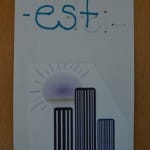Suffix -est vs -ist: Meanings & Multisensory Activity
Posted by Brainspring on 4th Jun 2024

Today's rule for suffix -ist and -est depends on the type of word, not a certain feature of the word like most of the other rules. As always, this rule works most of the time, but you may run into some exceptions.
Most suffixes include a rule related to their spelling. Choosing between suffixes -ist and -est depends on the word type and its meaning rather than a particular feature (i.e., the ending of the base word).
The difference between suffixes -ist and -est is simple: words ending in the suffix -ist refer to a noun, while words ending in the suffix -est refer to an adjective. As always, the rule taught in this activity usually works, but you may run into some exceptions.
Meaning Matters: Suffix -ist & -est Definitions
The endings of “artist” and “longest” sound the same. It’s necessary to consider the word type when adding suffixes -ist or -est.
Suffix -ist Meaning
Typically, the suffix -ist describes a person who practices, is an expert in something or is associated with a particular field of study or activity. It denotes a profession, an ideological stance, or a characteristic tendency. For example, a dentist is a person who specializes in dentistry.
Suffix -ist in a sentence:
- The artist spent hours painting the landscape on her canvas.
- The pianist received a standing ovation for his performance.
Suffix -est Meaning
In contrast, the suffix -est is often applied to superlative adjectives and adverbs, indicating the most significant degree of quality. For instance, the word small becomes smallest, showing that something is the least in size or amount. Typically, the suffix -est compares two or more objects.
Suffix -est in a Sentence:
- She always keeps up with the latest fashion trends to stay in style.
- Despite being the smallest puppy in the litter, he has the most lively personality.
Make it Multisensory: Suffix -ist & -est Activity
The rules of the game are simple and stated below:
- Using the words below or your own list, tell students a word.
- The students will hold up the -est or -ist side of their note cards and then write the word in the proper column on a separate sheet of paper.
- After you have gone through the word list, the students will use the words in sentences. For each sentence, they need to include one -ist word and one -est

Example sentences:
My favorite artist created the coolest painting in the museum.
The optimist turned a rainy day into the happiest day of his life.
Suffix -est & -ist Words
Here are some additional suffix -ist and -est words to get you started with this activity:
Suffix -ist Words
- Chemist
- Artist
- Biologist
- Therapist
- Optimist
- Dentist
- Pianist
- Astronomist
- Bicyclist
- Tourist
Suffix -est Words
- Longest
- Tallest
- Happiest*
- Busiest*
- Sweetest
- Coolest
- Brightest
- Darkest
- Healthiest*
- Cushiest*
The words with a “*” follow the Y Plus a Suffix rule. When a word ends in a consonant followed by a "y," and the suffix begins with a vowel, the "y" is typically changed to "i" before adding the suffix. This rule helps maintain pronunciation and ensures clarity in the word's spelling.
Understanding the difference between suffixes -ist and -est is an important part of helping students build a stronger foundation in spelling and vocabulary. Through engaging, multisensory activities, students can practice applying these suffixes while enhancing their understanding of language patterns. With consistent practice and fun activities, students will gain confidence in distinguishing between these suffixes and using them accurately in their writing.
Add sentences you or your students came up with in the comments below!
Share and Subscribe if you love multisensory activities for spelling!
